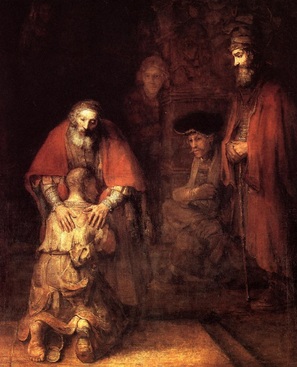Rembrandt, Return of the Prodigal, 1668
A Study Guide by Lee Magness

At some point in your studies of the parable of the Prodigal Son you will experience Henri Nouwen's wonderful book, The Return of the Prodigal Son, a multi-faceted meditation on this masterful painting by Rembrandt. But for now I want us to encounter the painting more directly and more personally, with our own eyes.
Rembrandt was drawn to Jesus' parable of the Prodigal Son throughout his painting career. As a younger man Rembrandt painted himself and his wife Saskia as the younger son and a bar girl/prostitute in a depiction of life in the far country. As he aged, Rembrandt completed several drawings of the younger son--often depicted as an old man!--among the pigs or returning home. Then shortly before his death, Rembrandt painted this most famous artistic rendering of the parable. It hangs in the Hermitage Museum in St. Petersburg, Russia, and continues to influence painters, writers, choreographers, filmmakers, as well as theologians like Nouwen.
Reflection
Consider the following questions as you study the painting (you may want to access a larger version of the painting
online so you can see its details more clearly.
1) Where is your eye drawn as you first look at the painting? How? Why?
2) Where is your sight attracted secondarily? How? Why?
3) What is most noticeable about the father? What do you make of his face, his posture, his clothing, his hands?
4) What is most noticeable about the younger son? What do you make of his posture, his clothing, his feet?
5) What is Rembrandt trying to communicate about the older son? What do you make of his position in the painting,
his clothing, his posture, his hands?
6) What are you reminded of by the presence of others in the painting?
Response
Write a short essay sharing your interpretation of the painting or write a short meditation on the meaning of the
parable as illustrated by this painting.
After you have finished writing your response, click on this link to read about Henri Nouwen's interpretation of the painting in his highly-regarded book The Return of the Prodigal Son.
Rembrandt was drawn to Jesus' parable of the Prodigal Son throughout his painting career. As a younger man Rembrandt painted himself and his wife Saskia as the younger son and a bar girl/prostitute in a depiction of life in the far country. As he aged, Rembrandt completed several drawings of the younger son--often depicted as an old man!--among the pigs or returning home. Then shortly before his death, Rembrandt painted this most famous artistic rendering of the parable. It hangs in the Hermitage Museum in St. Petersburg, Russia, and continues to influence painters, writers, choreographers, filmmakers, as well as theologians like Nouwen.
Reflection
Consider the following questions as you study the painting (you may want to access a larger version of the painting
online so you can see its details more clearly.
1) Where is your eye drawn as you first look at the painting? How? Why?
2) Where is your sight attracted secondarily? How? Why?
3) What is most noticeable about the father? What do you make of his face, his posture, his clothing, his hands?
4) What is most noticeable about the younger son? What do you make of his posture, his clothing, his feet?
5) What is Rembrandt trying to communicate about the older son? What do you make of his position in the painting,
his clothing, his posture, his hands?
6) What are you reminded of by the presence of others in the painting?
Response
Write a short essay sharing your interpretation of the painting or write a short meditation on the meaning of the
parable as illustrated by this painting.
After you have finished writing your response, click on this link to read about Henri Nouwen's interpretation of the painting in his highly-regarded book The Return of the Prodigal Son.
